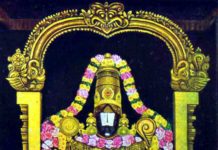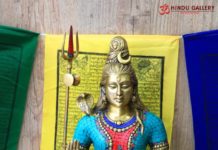Sri Tulja Bhavani Mandir is the temple ascribed to Sri Bhavani Devi, one of the manifestations of Sri Parvathi Devi. The temple is situated at Tuljapur at Osmanabad District of Maharashtra. Tuljapur was earlier known as Chinchpur.
Shakthi Peet
This temple is one of the four Shakthi Peets situated at Maharashtra. The other three Shakthi Peet temples are Sri Renuka Mandir at Mahur, Sri Mahalakshmi Mandir at Kohlapur and Sri Saptha Shringi at Vani.
The specialty of Sri Tulja Bhavani is that the main Deity Herself is taken out in procession around the temple. For three times in a year, Sri Tulja Bhavani also takes rest.
Origin
The temple is believed to be built around 12th Century A.D.
Legend
There are a few legends pertaining to the incarnation of Sri Tulja Bhavani.
Madhu-Kaitabha
Two demons named Madhu and Kaitabha were creating mayhem in the universe. Devas and humans have suffered severely.
Devas sought help from Sri Brahma Deva. Sri Brahma had told that only Maa Sri Shakthi could protect them. So, they all devoutly prayed to Sri Shakthi.
Sri Shakthi took the form of Sri Tulja Bhavani. As She Herself was one of the Saptha Mathas, She took help from the other Saptha Mathas such as Sri Varahi, Sri Brahmi, Sri Vaishnavi, Sri Aindri, Sri Kaumari and Sri Shambavi. With the help of the rest of the Saptha Mathas, Sri Tulja Bhavani had destroyed the demons.
Mahisha
As per another legend, a demon named Mahisha had disguised himself as a buffalo and was hiding in Yamunachala hill. He was hiding there to make plots to create havoc.
Sri Tulja Bhavani had diminished him. The temple is situated on the Yamunachala hill only. The hill is also called as Sahayadri hill and Bala ghat.
Anubhuthi
During Krita Yuga, there was a Sage named Kardam. His wife was Anubhuthi. They had an infant son. One day, the Sage had died. His wife Anubhuthi could not bear the loss. She too tried to enter the funeral pyre (Sati).
At that time, a celestial voice was heard. It said that Anubhuthi should look after her son. She had then realized her duties as a mother. She brought up her son as an independent young man.
When she felt satisfied that her son could take care of himself, she wanted to severe the ties with the worldly life. So She went to Meru mountain to do penance.
She did penance at the bank of Mandakini river. A demon named Kukur was disturbing her to marry him. When she refused, he tried to forcibly take her away.
Anubhuthi cried for help. Sri Tulja Bhavani appeared, fought with the demon and killed him. She asked Anubhuthi to ask for any boon. Anubhuthi said that she just wanted to be near Sri Bhavani Devi and always wanted to see her.
Sri Tulja Bhavani granted her the desired boon and asked her to stay in the Yamunachala hill.
Sri Rama
As per another belief when Sri Rama was searching for Sri Sita, He had visited here and took the blessings of Sri Tulja Bhavani.
Yudhistra
As per legend, it is believed that Yudhistra, the head of Pandavas had taken the blessings of Sri Tulja Bhavani prior to Mahabharatha war.
Chatrapathi Shivaji
Sri Tulja Bhavani is the family Deity of many royal and noble families. She is the Kula Devatha of the Emperor Shivaji. As per the legend, Sri Bhavani Devi had given the sword named ‘’Bhavani Kadga” to Shivaji for winning over his enemies.
Structure
The main entrance is called as Mahadwar. It bears the name Nimbalkar Darwaja. The other two entrances have the names of the parents of Shivaji Shahaji and Jijau (Raja Shahaji Mahadwar and Rajmata Jijau Mahadwar).

On entering through the main entrance, the shrine dedicated to Sri Markandeya Maharishi can be seen on the right side. The stairs are to be descended to reach the main sanctum. The Yagna Kunda is in the front of the main sanctum.

On getting down from the stairs, there are two water bodies, Gomukh Theerth on the right side and Kallol Theerth on the left side. The devotees invariably take holy dip in these ponds before entering the main sanctum.
The main sanctum is the stone mandap built with stones. There are many sculptures on the pillars. There is open space in all the four sides around the main sanctum.

The main Deity Sri Tulja Bhavani is called as Tulaja, Turaja, Tvarita, Amba, Ambabai, Tukai, Bhagavathi and Jagadamba. The vigraha is made of the stone taken from Gandhakee river. There is also a belief that the main Deity is a Swayambu, the self-manifested one.

She is depicted with eight hands. Sun and moon are depicted on Her shoulders.
On the right side, the upper hand holds Chakra, the holy wheel; The next hand holds an arrow; The next has the dagger and the lower hand holds a trident.
On the left side, the upper hand holds the Shank, the holy conch; the next hand has a bow; the next holds a bowl and the lower hand holds the head of Mahishasur.
Her right foot is on the slain body of the demon Mahishasur. The left foot is on the ground. Her Vahan is Simha, the lion.
It is believed that Sri Adi Sankaracharya had installed the Main Deity on the Shri Yanthra. The main Deity is non-static. She is called Chala Murthy. During festivals, the Deity Herself is removed from Her pedestal and taken round the temple in procession.
The Shrine of Sri Eshwara is right opposite Sri Tulja Bhavani Sanctum.
Other shrines
There are dedicated shrines for Sri Dattatreya, Siddhi Vinayak, Adhi Shakthi, Aadi Matha Mathanga Devi and Sri Annapurna within the temple premises. Another Theerth named Amruth Kund is also present.

Rituals
Tuesday, Friday, Purnima and Durgashtami are considered as auspicious and as such special Pujas are done to Sri Tulja Devi. Navrathri is grandly celebrated here.
The special Pujas done at the temple are Abhishekam, Puran Poli Neivedyam, Ooti Puja, Simhasan Puja, Kalyanam, Saptha Shathi Path, Gondhal Puja and Haldi Kumkum Archana.
Festivals
Navartra festivals are celebrated in great fervor in the temple.
Sharadiya Navratra
This occurs during the Dassara festival. Dassara is grandly celebrated in the temple. The ten days are called as Ashwin Shudh.
It is believed that the Goddess goes to sleep for five days upto the full moon day. The festival named Simollanghan is observed. For this festival, the vigraha of Sri Tulja Bhavani is taken out of the Garbha Graha early in the morning, placed on the palanquin and taken around the main sanctum inside the temple in procession. Then Sri Bhavani Devi is believed to go to sleep for five days. She is believed to wake up again on Full moon day.
Shakambari Navratra
This is celebrated for five days in Paush month. Traditional Music concerts are held in the premises.
Nidra festivals
Moha Nidra is celebrated on Ashvina Shudha Dasahmi. The Vigraha from Garbha Gruha is taken out and kept in Palanquin in resting position. After the perambulation inside the temple, the Vigraha is kept in resting position on the special palanga.
Ghora Nidra is celebrated on Bhadra Pada Krishna Ashtami. The Vigraha is smeared with turmeric and kept in resting position on special silver cot.
Maya Nidra is celebrated on Pausha Shudha Pradhipadha. The Vigraha is smeared with turmeric and kept in resting position on special silver cot.
Chhabina
This is celebrated on Full moon day. The silver replica of Sri Tuja Bhavani Devi is kept in a chariot where the lions, elephants, horses, bulls, eagles and peacocks are depicted. The chariot is taken around the main sanctum as the parikrama.
Timing
The temple is open at 5 A.M. Abhishek, Puja and Nevedyam are done from 6.00 A.M to 11.00 A.M. Darshan is allowed after that. Evening Puja is from 6.00 P.M to 9.00 P.M. The main door is closed at 10.00 P.M
The timing may differ on special occasions.
How to reach
The temple is around 40 kilometers from Sholapur. Buses are available. From Tuljaur bus stand, autos can be hired to reach the temple.
All the shops around the temple sell green bangles and the dolls of green parrots. Most of the ladies visiting the temple wear green color dresses. The significance of green could not be ascertained.









































